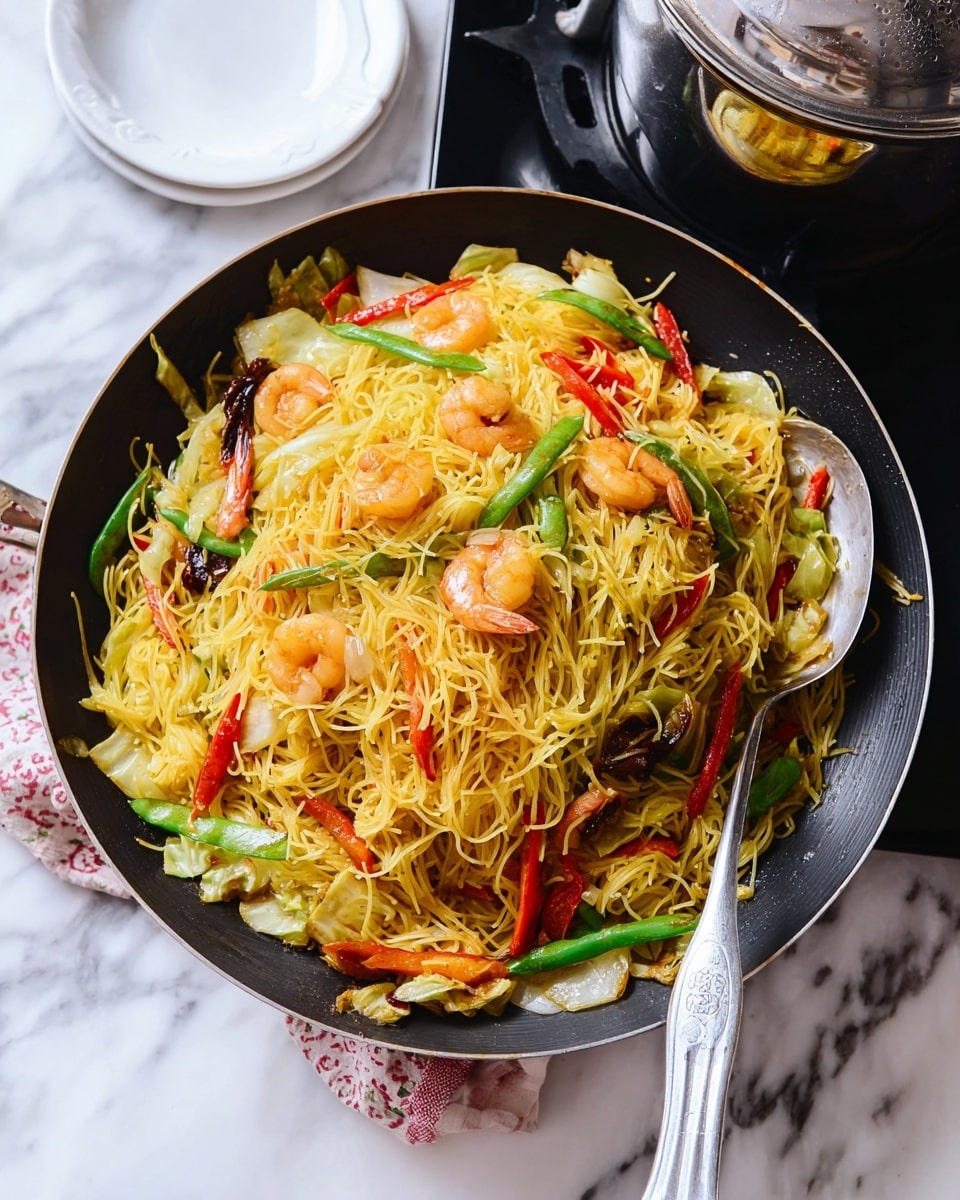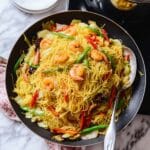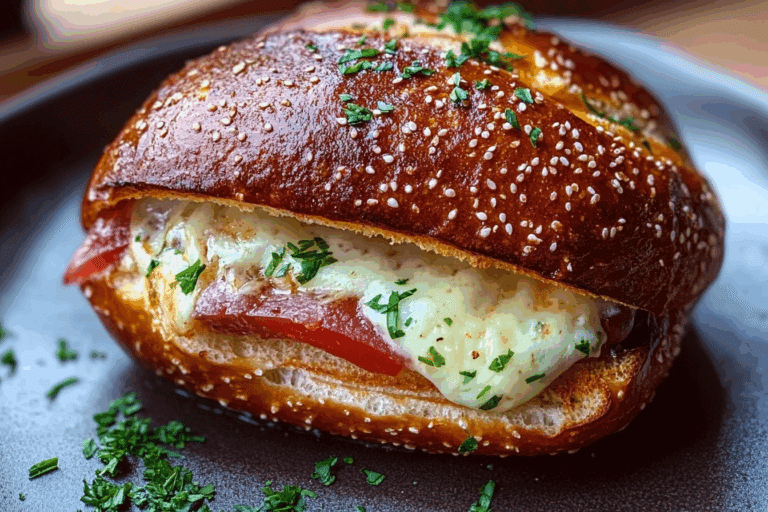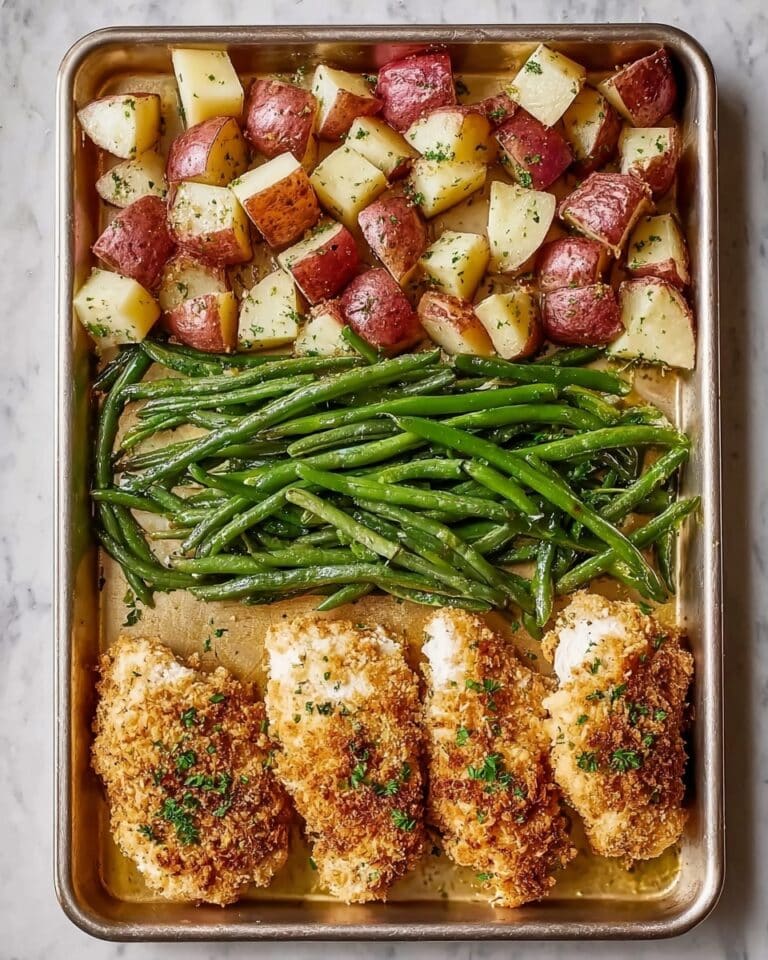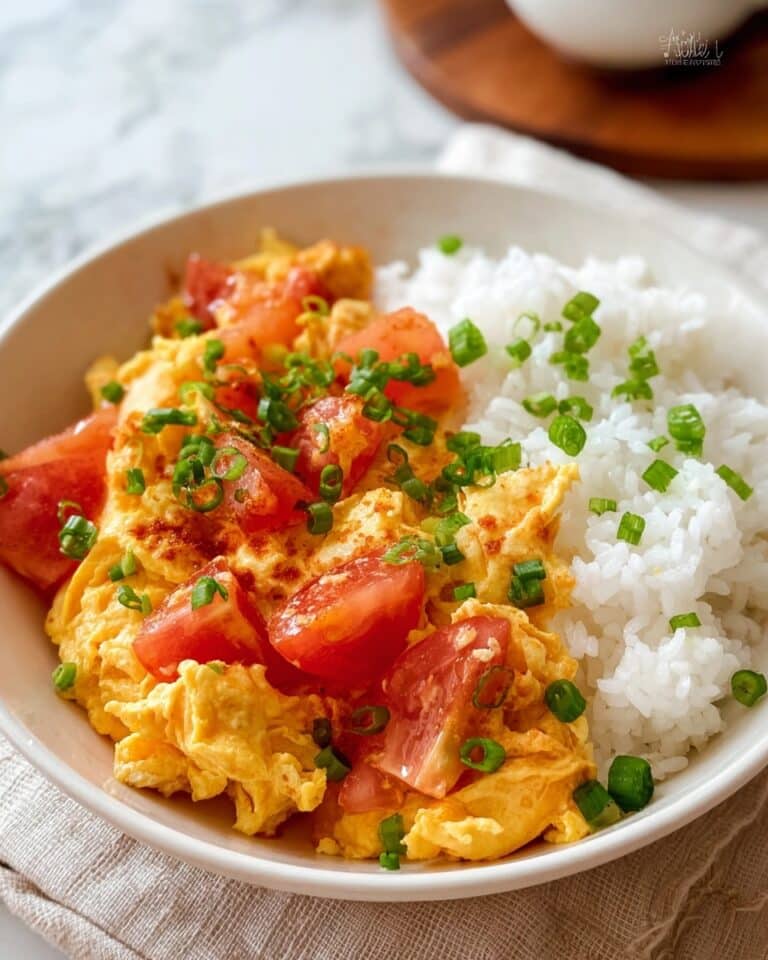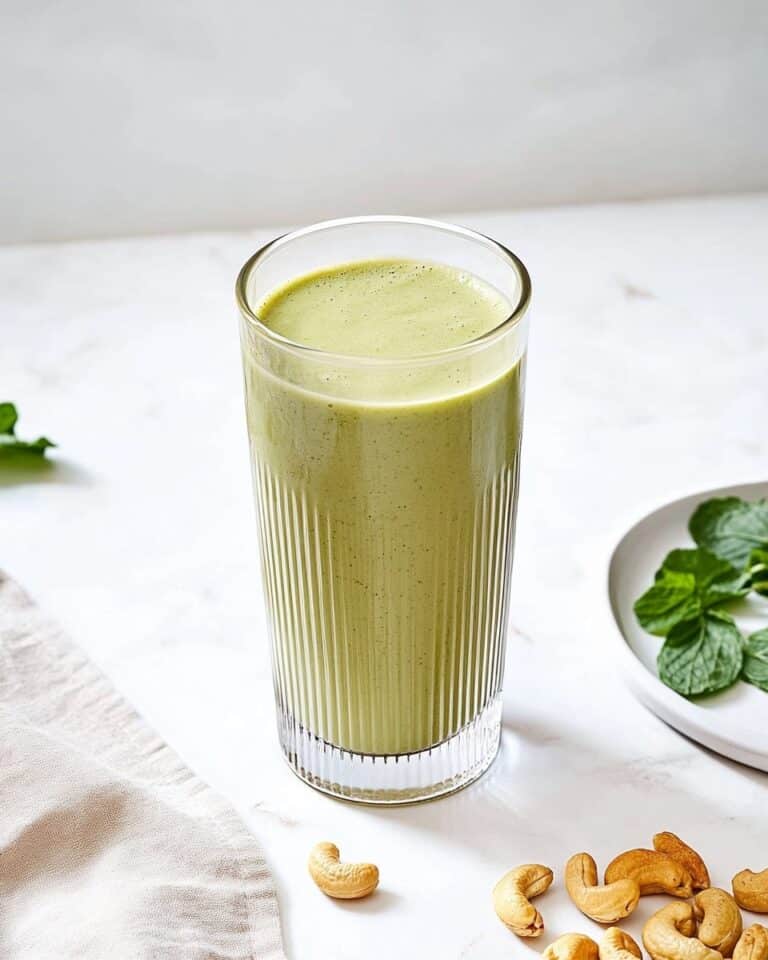Singapore Rice Noodles Recipe
If you’re craving something vibrant, flavorful, and just a little bit exotic for your dinner tonight, you’re going to love this Singapore Rice Noodles Recipe. It’s a colorful stir-fry packed with shrimp, roast pork, and crisp veggies, all wrapped up in the aromatic embrace of curry powder and sesame oil. Honestly, every time I make this dish, it feels like a small celebration in my kitchen—there’s just something about those fragrant spices combined with tender noodles that brightens up even the busiest weeknight.
What’s great about this Singapore Rice Noodles Recipe is not just the flavor but also its versatility and speed. Whether you want a quick lunch fix or a dinner that impresses friends with minimal fuss, this recipe has your back. Plus, it’s a wonderful way to use up leftover roast pork or ham, so you get convenience without sacrificing taste. I’m excited to share all my tips for keeping the noodles perfect and the flavors balanced, so let’s get cooking!
Ingredients You’ll Need
This recipe balances proteins, fresh veggies, and bold seasonings perfectly. When you pick your ingredients, look for fresh shrimp and crisp vegetables, and make sure you get dried rice stick noodles that are just the right thickness for stir-frying.
- Shrimp: Fresh or thawed shrimp work best for that sweet seafood pop.
- Canola or vegetable oil: Neutral oils keep the flavors bright and don’t overpower the curry.
- Asian fish sauce: Adds a savory depth—don’t skip this, it’s key!
- Dried rice stick noodles: Look for medium thickness; soba or pad thai noodles aren’t quite the same.
- Garlic: Fresh minced garlic delivers that punch of fragrance and layers the flavor exquisitely.
- Curry powder: Divided use here means you get aroma upfront and flavor throughout.
- Soy sauce: Adds umami and seasoning without salt overload.
- Shaoxing wine: This traditional Chinese cooking wine brightens and tenderizes the proteins.
- Ground white pepper: Just a pinch adds subtle heat, different from black pepper’s bite.
- Sugar: Balances the tang and spice perfectly.
- Eggs: Beaten with salt, for soft ribbons of fluffy texture.
- Chinese roast pork (char siu) or ham: Adds sweetness and that lovely meaty texture.
- Onion: Thinly sliced for quick cooking and crunch.
- Red bell pepper: For sweetness and vibrant color.
- Snow peas: Crisp and slightly sweet, sliced thinly on the bias.
- Carrot: Julienne for crunch and a pop of orange.
- Kosher salt: To taste, seasoning everything just right.
- Scallions: Thinly sliced for freshness and color at the end.
- Toasted sesame oil: Adds nutty aroma—you’ll drizzle this at the end for maximum effect.
Variations
I love mixing this recipe up depending on what’s in my fridge or how adventurous I’m feeling. Don’t hesitate to make it your own by swapping proteins or adjusting spice levels. It’s your kitchen, so have fun with it!
- Vegetarian Variation: I’ve subbed tofu for shrimp and pork with fantastic results—just make sure to press and marinate the tofu well for flavor.
- Spicy Kick: Adding a dash of chili paste or fresh sliced chilies really wakes up the dish if you like heat.
- Seafood Mix: Sometimes I blend shrimp with scallops or squid for a seafood feast vibe.
- Gluten-Free: Use tamari instead of soy sauce and double-check your fish sauce for gluten-free labeling.
- Seasonal Veggies: Swap in snap peas, baby corn, or bok choy, depending on what’s fresh.
How to Make Singapore Rice Noodles Recipe
Step 1: Prep Your Noodles and Ingredients
Start by soaking your dried rice noodles in warm water until just soft but still chewy—usually about 15-20 minutes. Don’t over-soak them to avoid mushiness later when stir-frying. Meanwhile, prep everything else: peel and devein the shrimp, julienne your veggies, slice the roast pork thin, and beat your eggs with a pinch of salt. Having everything ready to go makes the cooking process quick and smooth, so set your stage well.
Step 2: Master the Stir-Fry Technique
Heat 2 tablespoons of oil in a large wok or skillet over high heat until it’s shimmering. Toss in the shrimp and stir-fry just until they start turning pink, about 1-2 minutes—be careful not to overcook here! Remove and set aside. Then add a bit more oil, sauté your garlic and onions until fragrant, and sprinkle half the curry powder. This releases the spices beautifully. Add eggs next and scramble gently until just set.
Step 3: Combine Everything and Season
Now, toss in your noodles, pork strips, and veggies. Add the shrimp back in and drizzle with fish sauce, soy sauce, Shaoxing wine, sugar, white pepper, and the rest of the curry powder. Stir everything together briskly so the noodles soak up those gorgeous spices evenly. I usually taste and adjust seasoning here—sometimes a pinch more fish sauce or a dash of soy sauce sets the balance just right.
Step 4: Finish with Scallions and Sesame Oil
The final touch? Toss in your thinly sliced scallions and drizzle toasted sesame oil for that irresistible nutty aroma. Give everything one last quick toss, and you’re ready to serve. Trust me, this step makes all the difference for authentic flavor that’ll have everyone asking for seconds.
How to Serve Singapore Rice Noodles Recipe
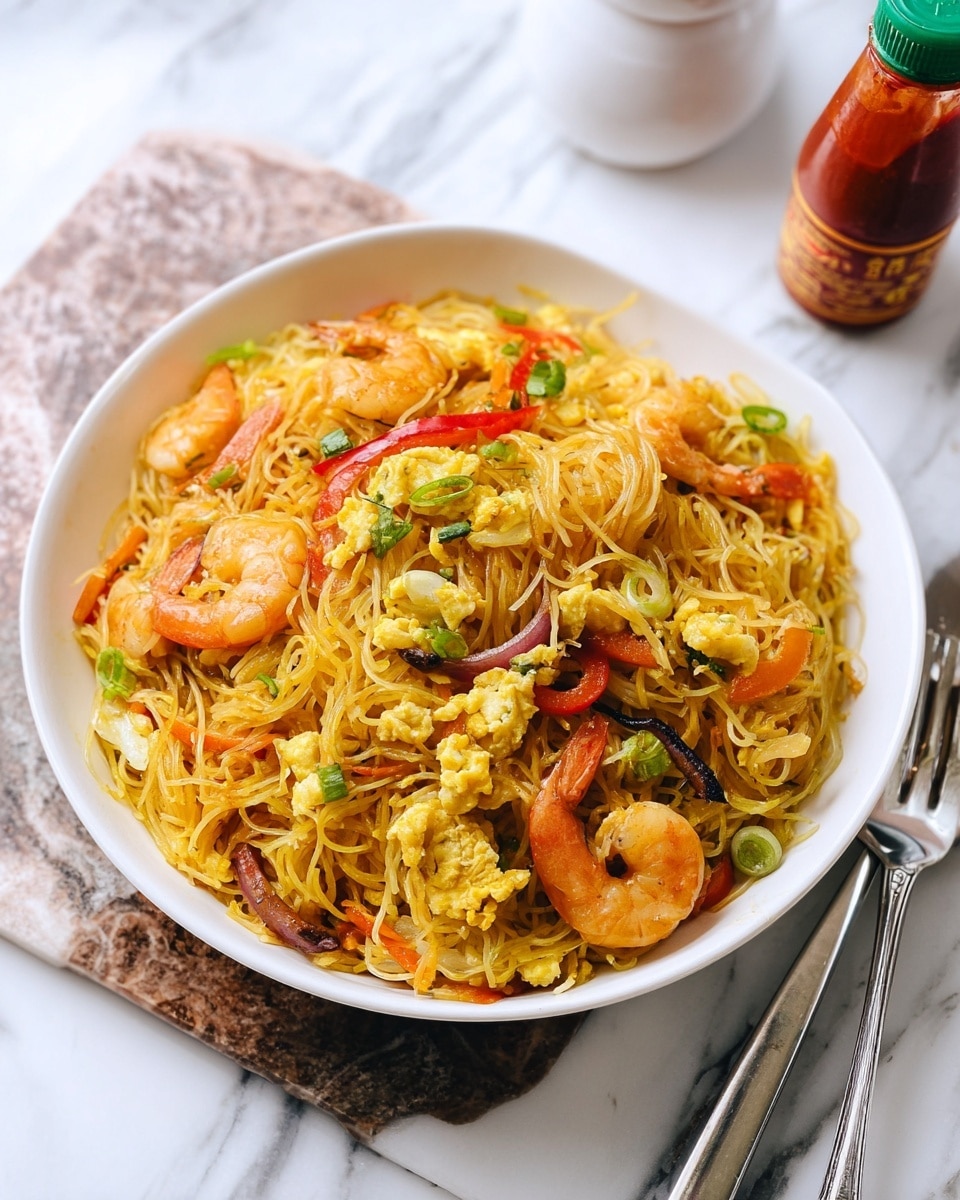
Garnishes
For garnishes, I love sprinkling extra sliced scallions and a few fresh cilantro leaves for color and brightness. If you like a little heat, some fresh red chili slices or a squeeze of lime brightens up the whole bowl wonderfully. Crispy fried shallots on top add a fun crunch too, if you’re feeling fancy.
Side Dishes
Pair this Singapore Rice Noodles Recipe with simple sides like steamed dumplings or a crisp cucumber salad to contrast the warm, spiced noodles. I’ve also found that a bowl of hot miso soup complements the meal well, especially on cooler nights.
Creative Ways to Present
For a dinner party, I sometimes serve these noodles in little lettuce cups that double as handheld bites, making it interactive and fun. Or, pile a colorful mound on a large platter and let everyone help themselves, surrounded by those garnishes and condiments for personalization.
Make Ahead and Storage
Storing Leftovers
I store leftover Singapore Rice Noodles in an airtight container in the fridge and try to eat them within 2 days. The noodles hold up well but the veggies soften a bit over time, so I recommend reheating gently to keep them from getting too mushy.
Freezing
Freezing works in a pinch, but I find the texture changes slightly afterward—noodles can get a little clingy. If you plan to freeze, cool completely and freeze in portion-sized containers. Thaw in the fridge overnight before reheating.
Reheating
The best way to reheat leftover Singapore Rice Noodles Recipe is in a hot wok or skillet with a splash of oil over medium-high heat. Toss quickly just until warmed through to revive the noodles’ texture and avoid overcooking the shrimp or vegetables again.
FAQs
-
Can I use fresh rice noodles instead of dried ones for this Singapore Rice Noodles Recipe?
Absolutely! Fresh rice noodles work great and can save you some soaking time. Just be gentle when stir-frying since fresh noodles are more delicate and can break apart if overhandled.
-
How spicy is the curry powder in this Singapore Rice Noodles Recipe?
The curry powder used is mild and aromatic rather than fiery. However, you can always add chili flakes or fresh chilies if you prefer a spicier kick.
-
What’s the best way to prevent the rice noodles from sticking together?
Soaking the noodles until just tender and then draining them well is key. Also, tossing them with a bit of oil before adding to the wok helps keep the strands separate during cooking.
-
Can I substitute the shrimp and pork with chicken?
Definitely! Thinly sliced chicken breast or thighs work well; just stir-fry until cooked through before adding the other ingredients.
-
Is Shaoxing wine necessary, and can I substitute it?
Shaoxing wine adds authentic depth, but if you don’t have it, dry sherry or a splash of rice vinegar mixed with a bit of sugar can work as a substitute.
Final Thoughts
This Singapore Rice Noodles Recipe holds a special place on my table because it’s so reliable yet bursting with flavor. Once you get the hang of the quick stir-fry technique and balancing the seasonings, you’ll find yourself returning to this dish again and again—whether you need a comforting solo meal or a crowd-pleaser. I can’t wait for you to try it and discover how rewarding it is to whip up such an authentically delicious dish at home!
PrintSingapore Rice Noodles Recipe
Singapore Rice Noodles is a vibrant and flavorful stir-fried noodle dish featuring delicate rice stick noodles tossed with shrimp, Chinese roast pork, and a medley of colorful vegetables. Infused with the fragrant aroma of curry powder, garlic, and Asian fish sauce, this dish is a perfect balance of savory, spicy, and slightly sweet flavors, delivering a true taste of Southeast Asian cuisine at home.
- Prep Time: 30 minutes
- Cook Time: 15 minutes
- Total Time: 45 minutes
- Yield: 4 servings
- Category: Main Dish
- Method: Stovetop
- Cuisine: Singaporean
Ingredients
Protein and Meat
- 1/4 pound shrimp, shelled, deveined, and rinsed under cold water
- 1/4 pound Chinese roast pork (char siu) or ham, cut into thin strips
- 2 eggs, beaten with two pinches kosher salt
Noodles
- 1 bundle (about 5 1/2 ounces) dried rice stick noodles
Vegetables
- 1/4 medium onion, very thinly sliced
- 1/2 medium red bell pepper, stemmed, seeded and julienned
- 12 snow peas, stemmed, tough strings removed, and sliced thinly on the bias
- 1/2 medium carrot, julienned
- 2 scallions, sliced very thinly on the bias
- 2 medium cloves garlic, minced
Oils and Sauces
- 4 tablespoons plus 2 teaspoons canola or vegetable oil, divided
- 2 1/2 teaspoons Asian fish sauce, divided
- 1 teaspoon soy sauce
- 1 teaspoon Shaoxing wine
- 2 teaspoons toasted sesame oil
Spices and Seasonings
- 1 tablespoon curry powder, divided
- 1/4 teaspoon ground white pepper
- 1/4 teaspoon sugar
- Kosher salt
Instructions
- Prepare the Noodles: Soak the dried rice stick noodles in warm water until softened, typically 20-30 minutes, then drain and set aside.
- Cook the Shrimp: Heat 2 teaspoons of oil in a wok or large skillet over medium-high heat. Add the shrimp and stir-fry until pink and cooked through, roughly 2-3 minutes. Remove shrimp and set aside.
- Cook the Eggs: Add a bit more oil if needed. Pour in the beaten eggs and scramble gently until just cooked. Remove and set aside.
- Stir-fry Aromatics and Vegetables: Add remaining oil to the hot wok. Stir in minced garlic and 1 teaspoon curry powder; cook until fragrant about 30 seconds. Add onion, red bell pepper, snow peas, and carrot; stir-fry until vegetables are tender-crisp, about 2-3 minutes.
- Add Meats and Sauces: Return shrimp and eggs to the wok along with Chinese roast pork strips. Stir in soy sauce, Shaoxing wine, half of the fish sauce, remaining curry powder, ground white pepper, sugar, and a pinch of kosher salt. Mix well to combine flavors.
- Add Noodles: Add the soaked and drained rice noodles to the wok. Toss gently but thoroughly to combine all ingredients and coat noodles evenly with spices and sauces.
- Finish with Scallions and Sesame Oil: Stir in sliced scallions and drizzle toasted sesame oil over the dish. Adjust seasoning with remaining fish sauce if desired.
- Serve Hot: Remove from heat and serve immediately for the best texture and flavor.
Notes
- If dried rice stick noodles are unavailable, fresh rice noodles can be used; adjust soaking and cooking time accordingly.
- The amount of curry powder can be adjusted based on your preference for heat and spice intensity.
- Shaoxing wine adds authenticity and depth, but dry sherry can be substituted in a pinch.
- For a vegetarian version, omit shrimp and pork, and increase vegetables or add tofu.
- Ensure the wok or pan is hot enough to achieve a good stir-fry texture without steaming the ingredients.

